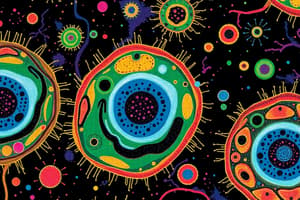Podcast
Questions and Answers
Which term is used to collectively refer to specialized structures and particles within the cytoplasm?
Which term is used to collectively refer to specialized structures and particles within the cytoplasm?
- Organelles (correct)
- Membranes
- Proteins
- Phospholipids
What is the function of organelles in a cell?
What is the function of organelles in a cell?
- Enabling cell communication
- Producing cell membranes
- Generating energy for movement
- Maintaining cellular homeostasis (correct)
What is the primary function of cell membranes?
What is the primary function of cell membranes?
- Enabling cell movement
- Facilitating cell division
- Regulating what enters and exits the cell (correct)
- Producing energy for the cell
Which process allows cells to carry out vital tasks such as respiration and metabolism?
Which process allows cells to carry out vital tasks such as respiration and metabolism?
What is the main role of the plasma membrane in a cell?
What is the main role of the plasma membrane in a cell?
What is the main function of the endoplasmic reticulum in a cell?
What is the main function of the endoplasmic reticulum in a cell?
Which organelle in a cell is responsible for converting energy stored in glucose or fats into a form usable by cells?
Which organelle in a cell is responsible for converting energy stored in glucose or fats into a form usable by cells?
What is the primary function of ribosomes in a cell?
What is the primary function of ribosomes in a cell?
During which cell process do chromosomes replicate and segregate evenly between daughter cells?
During which cell process do chromosomes replicate and segregate evenly between daughter cells?
Why are flexible membranes important for cells?
Why are flexible membranes important for cells?
Flashcards are hidden until you start studying
Study Notes
Unraveling Life's Building Blocks: A Deep Dive into Cellular Structure and Function
At its most basic level, life is built from cells — tiny compartments teeming with complexity and purpose. This fundamental unit of life, known simply as the cell, serves as the foundation upon which all other living structures rest. In this exploration, we will delve deeper into cell functions, their organization via cell membranes and structural components like organelles, and how they reproduce through cell division.
Cells as Living Machines
Cells act as self-contained units where various chemical reactions occur, allowing them to carry out vital tasks such as respiration, metabolism, movement, and communication. They're surrounded by fluid-filled sacs called membranes that regulate what enters and exits each cell while maintaining internal stability. The interior space of these membranous enclosures is referred to as the cytoplasm, within which specialized structures and particles exist – collectively termed organelles.
The Walls and Windows: Cell Membranes
The cell membrane, also known as the plasma membrane, plays a crucial role in maintaining cellular homeostasis. It consists primarily of phospholipids arranged in a bilayer structure and proteins embedded within it. These molecules allow selective passage of nutrients and waste products across the barrier separating a cell from its external environment. Unlike solid walls, flexible membranes enable cells to expand, contract, and adapt during growth and change.
Structural and Functional Organizations of Cells
A cell contains numerous specialised compartments responsible for specific processes. Some well-known examples of cell organelles and their roles include:
- Nucleus: Contains genetic material (DNA) necessary for protein synthesis and reproduction.
- Mitochondria: Convert energy stored in glucose or fats into a form usable by cells.
- Ribosomes: Produce proteins based on instructions found in DNA.
- Endoplasmic Reticulum: Assists in protein production and lipid synthesis.
Each of these organelles works together in harmony to ensure smooth functioning of the entire cell.
How Cells Replicate: Cell Division
To maintain life, cells must duplicate themselves periodically. Cell division involves two distinct stages—mitosis and cytokinesis—and results in the creation of identical copies of parent cells. During mitosis, chromosomes replicate and segregate evenly between daughter cells; once separated, cytokinesis physically divides the cytoplasm into two new cells. By dividing and multiplying, cells help tissues grow and repair damage caused by injury or aging.
In conclusion, understanding the fundamental unit of life requires exploring the interactions among cell structures, functions, and behavior. From simple bacteria to complex multicellular organisms such as humans, every living being can trace back its existence to the building blocks of life: cells.
Studying That Suits You
Use AI to generate personalized quizzes and flashcards to suit your learning preferences.




